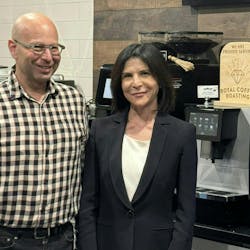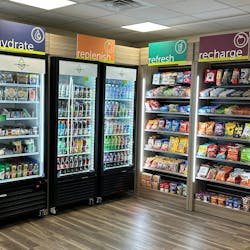Since micro markets really started to explode on the vending scene back in mid-2011, they have been a powerful force. In just a few years, they have gone from a nameless self-checkout system to driving nearly 9 percent of overall vending operation revenues. Yet, many operators are hesitant to open a micro market. The reasons range from concerns about theft to the true return on the investment when you consider the cost of a kiosk, additional SKUs of product, royalty fees and more. That’s why we asked a small groups of operators, all running successful micro market segments, to tell us about some of their biggest challenges, how they overcame them and what they see for the future.
The right choice
Today there are at least 10 separate providers of micro market systems who all offer different equipment, software and fee structures. Getting educated about the systems and choosing the best for your operation can be the first hurdle. This was probably the biggest challenge for Steve Toone, a Salt Lake City, UT-based operator with seven routes, when he decided to open his first micro market two years ago.
“Other operators in my area already had a platform,” said Toone. “Therefore, we didn’t want to use that one. We wanted to be different.” Toone turned to colleagues for help. He was a member of the USConnect alliance, which, at the time, had a contract with the micro market provider Revive. He opened his first Revive market in 2013 and hasn’t looked back.
“Customers really like the micro market,” said Toone. “I don’t see it going any way but up.” In two years, Toone has actually placed micro markets from three different providers, including the addition of Avanti Markets and Company Kitchen. He likes specific features of each system and really appreciates being able to see the particular way each provider goes about the business.
“Revive really lets the driver be efficient,” he said, “requiring fewer inventories, all of which can be done on a smartphone.” Avanti Markets offers many promotions that can be used with the USConnect card. Company Kitchen monitors product sales data and makes specific suggestions on what products to try in place of a slow seller. “It really makes it easy to merchandise and keep the market fresh,” said Toone.
That was another big challenge for Toone when he started out. As he converted 600 vending machines to 22 micro markets with only existing staff, he felt that merchandising was something that got left behind. “Merchandising is of no. 1 importance in a micro market,” said Toone. “You need to get new product options into the customers’ sights.”
For 94-route, Austin, TX vending operator Josh Rosenberg, the greatest challenge was also merchandising, both from a customer perspective, and also as an industry. “It’s important to properly merchandise for the space,” said Rosenberg.
Accent Food Services originally set a freezer in every micro market location. “Then we found the freezer is the highest cost of capital with the lowest return,” said Rosenberg, who finds it’s only about 6 percent of the revenue brought in by a typical micro market in his area. The lesson learned is that one size does not fit all locations. “We want to sell frozen products. We need to have it available, but now we are very careful where we place them,” he said.
It wasn’t just freezers, but the number of coolers, shelves, everything. “The biggest challenge every day is merchandising and not having the perception of empty shelves because that’s where the client’s mind ultimately goes,” said Rosenberg. Accent Food Services has experimented with placing stands and stackers that make a market look more robust and also spur sales. “We’ll do a pastry stacker at the register or a candy/gum stand similar to what you’d see at a retail location,” he said. “We are using that to drive impulse purchases to get a bigger ticket average as well as to expand our space and have allowable inventory on hand without putting down more capital outlay or having it all on the shelf.” In fact, the stacker becomes like a billboard, and it also frees up shelf space for other products.
The macro landscape
The way some operators look at micro markets and merchandise them to customers is another difficulty for Rosenberg. “We have competitors who are out selling micro markets more as a traditional vending platform,” explained Rosenberg, who is nervous this is lowering the perceived value of the service. “They are leaving dollars on the table in lieu of market share.”
Rosenberg believes these operators don’t understand that micro markets allow a vendor to sell and act as a retailer. It allows them to improve margins and be more competitive, not just with other vending operators, but with convenience stores and quick service restaurants. “Instead, some are coming in as the low cost, low value provider,” warned Rosenberg, “and diminishing value for everyone in our marketplace.”
Tom Bach, general manager at Sirness Vending Services, Inc. in Rochester, NY, agrees that a difference in thinking is really what drives successful micro markets. “Our biggest challenge when we first launched micro markets was breaking out of the ‘vending box’,” he said. It took the company a couple of months to realize that treating a micro market like an oversized vending machine wasn’t going to maximize the opportunity that markets presented. “Once we began to study the data, we realized we had an opportunity to better-serve certain day parts, such as breakfast and late-afternoon. As a result, we enhanced our coffee and breakfast offerings, and offered more grab-n-go fresh items for afternoon snacks as well as those offerings for on-the-go parents or folks stuck working late. As a result, we have been able to attract a more consistent crowd throughout the day, instead of just at lunch,” explained Bach. In fact, in hindsight, he would have dedicated more resources early on to running markets the right way. “At first, our markets were just another stop on the vending routes, but now they are much more,” admits Bach. “We have dedicated representatives servicing our markets, and a full pre-kitting section of the warehouse designed to accommodate our markets.”
The experience was similar for Five Star Food Service, Inc. out of Chattanooga, TN. “We would have invested in personnel resources that had retail experience,” explained Gregory McCall, senior vice president of sales and marketing, about Five Star’s learning curve as it established its micro market segment. Trying to expand with traditional vending personnel was a struggle. In addition, McCall cites other issues, including getting customers that were willing to test the concept as well as building a nice, dense micro market service route early on. “You have to be willing to open markets regardless of their location,” said McCall. “Initially, this creates very inefficient routes with lots of windshield time between stops. The faster you expand your market count, the faster you will be able to establish efficient micro market routes.”
Five Star had dedicated micro market routes from nearly day one, which McCall believes led to much of the company’s success in the segment. “After the first year of experimentation, we recognized that micro markets were a retail business and needed to be managed as such.” Five Star developed and executed promotions, as well as developed plan-o-grams for the snack and beverage categories of micro markets. Now the company even has separate warehouse space for its micro market division.
“To be successful in this space, you have to be ‘all-in’ and move as quickly as possible to gain a competitive advantage in the market. It takes a great deal of time and effort to build a platform that can eventually replace a large percentage of your vending business while delivering higher margins,” advised McCall.
One of the resources Toone dedicates to his micro markets is his commissary. None of the sandwiches or unique “sweet treats” line of products made at his company are sold in Kwik Vending vending machines. “I keep them separate so that customers understand these are special, good quality products,” said Toone. He also pushes the healthy items, especially among white collar or gray collar micro market locations because he is able to appeal to more consumers with a greater product mix.
A future that promises growth
All of the micro market operators in this roundtable discussion expect revenues from this segment to increase in the future.
Toone believes micro markets will become a larger percentage of sales. “I see micro markets making up 75 percent of my revenue in the next five years,” he said. “We have a quality product in our commissary.”
Bach sees markets being an important part of his long-term business strategy. “I could imagine market revenues equaling vending revenues in the next decade or so,” he said. “I believe there is a real opportunity for micro markets to take market share from subsidized manual food service in corporate locations. Employers will realize that micro markets are a viable alternative to cafeterias, with far less expense. And they’re open 24/7.”
Rosenberg views micro markets as an opportunity for mid to large size operators. “Every year, we get more solicitation for putting in a micro market — the move is being proactively driven by the client side,” he said. Plus, he believes there is enough data now to validate the ROI and sustainability of the micro market concept. “Ultimately, I believe it’s going to be the dominant percentage of revenue for vending operators within two or three years. We’re heading there now — where our micro market base is larger than our vending base.”
“Even with over 450 markets, Five Star is still seeing annual growth rates in excess of 45 percent,” said McCall. He believes even as the industry reaches its saturation point in the far future, there will still be significant growth in the micro market channel. “At Five Star, we are developing combo and loyalty programs that will dramatically improve our customer experience. Additionally, the ‘take-home’ market [where employees purchase items for home use] is still un-discovered territory with most micro market operators,” he said. The micro market concept will likely morph operators into other niches as well, like hotel pantry business, upscale apartment complexes and eventually, with future innovation, smaller accounts (25-100 employees).
Many operators have called micro markets the lift the vending industry has needed for a long time. Despite the costs involved, it is hailed as an opportunity to gain much more in a battleground for the corporate foodservice dollar.





